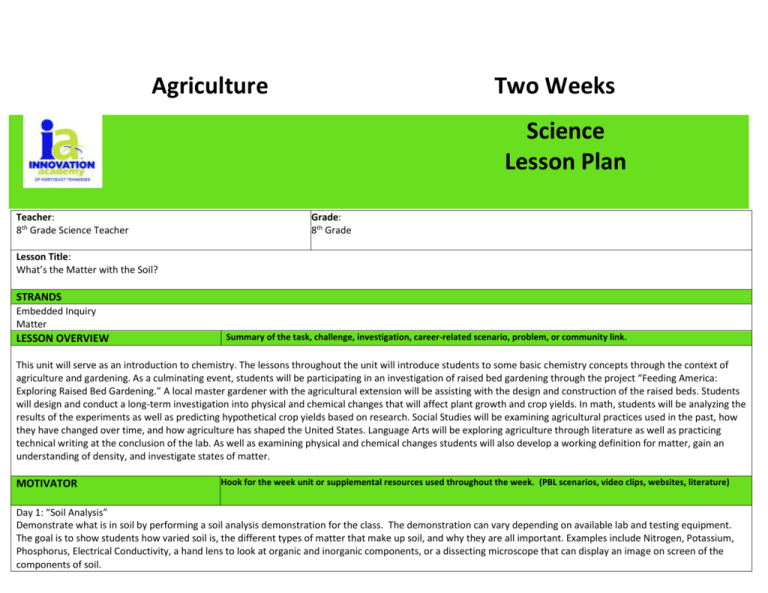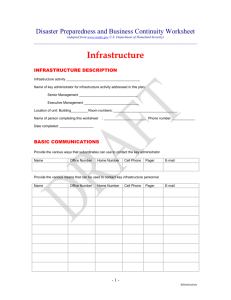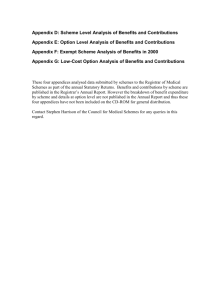8th Science Agriculture
advertisement

Agriculture Two Weeks Science Lesson Plan Teacher: 8th Grade Science Teacher Grade: 8th Grade Lesson Title: What’s the Matter with the Soil? STRANDS Embedded Inquiry Matter LESSON OVERVIEW Summary of the task, challenge, investigation, career-related scenario, problem, or community link. This unit will serve as an introduction to chemistry. The lessons throughout the unit will introduce students to some basic chemistry concepts through the context of agriculture and gardening. As a culminating event, students will be participating in an investigation of raised bed gardening through the project “Feeding America: Exploring Raised Bed Gardening.” A local master gardener with the agricultural extension will be assisting with the design and construction of the raised beds. Students will design and conduct a long-term investigation into physical and chemical changes that will affect plant growth and crop yields. In math, students will be analyzing the results of the experiments as well as predicting hypothetical crop yields based on research. Social Studies will be examining agricultural practices used in the past, how they have changed over time, and how agriculture has shaped the United States. Language Arts will be exploring agriculture through literature as well as practicing technical writing at the conclusion of the lab. As well as examining physical and chemical changes students will also develop a working definition for matter, gain an understanding of density, and investigate states of matter. MOTIVATOR Hook for the week unit or supplemental resources used throughout the week. (PBL scenarios, video clips, websites, literature) Day 1: “Soil Analysis” Demonstrate what is in soil by performing a soil analysis demonstration for the class. The demonstration can vary depending on available lab and testing equipment. The goal is to show students how varied soil is, the different types of matter that make up soil, and why they are all important. Examples include Nitrogen, Potassium, Phosphorus, Electrical Conductivity, a hand lens to look at organic and inorganic components, or a dissecting microscope that can display an image on screen of the components of soil. DAY 1 Objectives (I can….) Materials & Resources I can define matter. What is Matter Presentation I can give examples of matter and non-matter. I can explain that all matter is made of atoms. Students Journals or Journal iPad app such as Noteledge Matter and Non-Matter Cards Instructional Procedures Differentiated Instruction Assessment Essential Question(s): Remediation: 1. How can I define matter? 2. What are examples of matter and non-matter? 3. How can I explain that all matter is made of atoms? Unit Hook: Start with the unit hook on Soil Chemistry Heterogeneous grouping Formative Assessment: Set: Have students reflect on what they already know about matter by having them respond in their journals to the following questions: "What is matter? Give two examples of matter and two examples of non-matter." Teaching Strategy(s): What is Matter Activity Student Instructions Whiteboard or Presentation app for iPad such as Doceri Frayer Diagram (See Appendix B) 1. Start by introducing a student discovery activity about matter. If chemistry is the study of matter then to understand chemistry they must first understand what matter is. Through this activity students will collectively define matter. 2. Explain the student discovery activity. Students will be given a list of items they will categorize as matter, non-matter, or unsure. They will create a chart depicting their classification. Students will then develop a rule or definition for each category. Differentiation can be achieved by choosing more or less difficult cards based on student ability levels. 3. Have students report on what they discussed in their groups. Start by discussing some of the “easier” cards. Then have students report on what they discussed on the trickier cards. Next have students share the definitions they developed. Finally, narrow down to one definition the class can agree on. 4. Finish the activity by presenting definitions of matter and comparing and contrasting them to the definition they developed. Summarizing Strategy: Have students repeat their pre-activity journal reflection at Providing a handout or digital copy of the notes Selection of easier matter v. non-matter cards Enrichment: Heterogeneous Grouping and peer tutoring More difficult selection of matter v. nonmatter cards Journal Writing Set – used as preassessment Observations and questioning during the activity Student definition of Matter Reflective journal writing Summative Assessment: End of unit Assessment (See Appendix A) the end of the class to determine how students' ideas might have changed. Homework: Complete a Frayer Diagram for the word Matter 2 I can explain that all matter is made of atoms. I can explain that matter has properties that are determined by the structure and arrangement of its atoms. ice Essential Question(s): Remediation: water 1. How can I explain that all matter is made of atoms? 2. How can I explain that matter has properties that are determined by the structure and arrangement of its atoms? Students will be given a copy of the notes on the States of Matter. 100ml beaker hot plate thermometer or probeware with temperature sensor Ice Water preassessment States of matter presentation Melting Ice Lab (See Appendix C) Set – Start with the “Ice Water” pre-assessment. Students will read a situation about ice in a water glass, choose one explanation, and explain why they feel that explanation is correct. Teaching Strategy(s): 1. Begin the lesson with a short presentation on the different states of matter and the transitions from state to state. 2. Start with the lab activity on determining when water undergoes a phase change as well as determining how much energy it takes for a complete phase change. Students will start with a beaker containing a small amount of water and some ice. Students will then take the temperature of the beaker. Next place the beaker on a hot plate on medium heat. They will continue to take the temperature of the beaker every 30 seconds. Students will collect the data in a table and then graph the results. 3. Students will work with their partner to complete the graph of the data and to answer the analysis questions from the lab. Summarizing Strategy: Act it out! – Students will work in groups of 4 to act out the different phases of matter. Each student will represent an atom or molecule. Students will be heterogeneously grouped to allow peer tutoring and collaboration. Enrichment: Students can be given an alternative experiment where they freeze water. They will collect similar data and Formative Assessment: Ice Water PreAssessment In class observations and questioning Student work – Graphs and tables Data Analysis Questions Performance Assessment: Observations during the lab on Safety Procedures Summative Assessment: End of unit assessment (See Homework: Finish the graphs from the lab and complete the analysis questions from the lab. 3 Project Day – See Unit Plan Feeding America: Exploring Raised Bed Gardening – Research and Planning create a similar graph. (see Appendix C – Melting Ice Lab) Appendix A) 4 I can describe the particulate model of matter for a solid liquid and gas. I can understand the arrangement, motion, and energy of the particles in each phase. Macbook or laptop Matter Simulation Apple TV State of Matter Students Lab Handout State of Matter lab Preassessment (See Appendix D) Formative Assessment: Essential Question(s): Remediation: 1. How can I describe the particulate model of matter for a solid liquid and gas? 2. How can I understand the arrangement, motion, and energy of the particles in each phase? Students can be heterogeneously First Word-Last grouped to Word utilize peer Pre-assessment tutors. from the lab Students can be Observation and given a modified assignment with questioning during the lab less choices by only having the Performance word “Matter” Assessment: during the set Observation of and closure student use of the activity. simulation Set: First Word … Last Word - Students write the phrase “STATE OF MATTER” vertically down the page and use each letter to create an acrostic detailing what they already know about Matter and the states of matter. Teaching Strategy(s): Students will be conducting an online simulation of molecules and elements to observe how they behave under changes in temperature and pressure. 1. Students will complete the State of Matter lab pre-assessment. The instructor can circulate to observe student responses and to assess prior student knowledge. 2. Teacher should demonstrate how to access the simulation and explain how the different controls function. 3. Students will then begin the lab. Instructor can assist students as needed with opening the lab. Students will be grouped based on the previous days assessment as well as the set activity. 4. Students will then complete the analysis and extension questions from the lab Summarizing Strategy: First Word … Last Word – This is a continuation of the activity used to start the lesson. Students write the phrase “STATE OF MATTER” vertically down the page and use each letter to create an acrostic detailing what they learned during the lesson. Remind them to be detailed. Enrichment: Summative Assessment: Students can End of unit explore how assessment (See pressure and Appendix A) more matter can affect phase changes of matter and answer the extension questions at the end of the lab. 5 I can identify the common outcome of all chemical changes. I can identify chemical and physical properties of matter. iPad Essential Question(s): Remediation: Apple TV 1. How can I identify the common outcome of all chemical changes? 2. How can I identify chemical and physical properties of matter? Students can be given a list of physical and chemical properties to be used during the lab. (see Appendix E) Physical and Chemical Properties presentation Physical and Chemical Properties Lab Physical and Chemical Properties Lab write-up Physical and Chemical Properties Homework List of Physical and Chemical Properties Set – Students will start with a Think/Pair/Share activity using terms Property, Physical, and Chemical. Students will think and write about what they know about these terms, pair up with another student, and share. Teaching Strategy(s): Students will learn about chemical and physical properties of matter. 1. Start with a short presentation on Physical and Chemical Properties of matter. 2. Introduce the Chemical and Physical Properties lab. Students will investigate various forms of matter to determine physical and chemical properties. 3. After the lab starts, circulate around the room. Students will participate in a performance assessment on procedures. They must demonstrate clearly written procedures that they are actually following. 4. Students will then complete the physical and chemical properties lab write-up. For Lab Materials: see lab handout Summarizing Strategy: Properties Walk – Display the various elements of the lab throughout the room. Have students write one chemical and one physical property for each type of matter they observed on an index card and place it with that type of matter. Students will then circulate around the room and observe. Have students make note of any they disagree with and discuss these as a class. (See Appendix E) Homework: Classifying Physical and Chemical Properties. Students will classify a list of properties as chemical or physical. Students can be heterogeneously grouped to utilize peer tutors. Students can be given a copy of the presentation. Enrichment: Students can serve as peer tutors. More detailed and complete procedures during the lab. Formative Assessment: Think/Pair/Share set activity Chemical and Physical Properties lab Lab Write-up Performance Assessment: Students writing and following procedures Summative Assessment: End of unit assessment (See Appendix A) 6 I can identify the common outcome of all chemical changes I can identify chemical and physical properties of matter I can Interpret data from an investigation to differentiate between physical and chemical changes. iPad Essential Question(s): Remediation: Apple TV 1. How can I identify the common outcome of all chemical changes? 2. How can I identify chemical and physical properties of matter? 3. How can I Interpret data from an investigation to differentiate between physical and chemical changes? Students can be given a list of physical and chemical changes to be used during the lab. (see Appendix F) Sugar Sugar Water Pre-Assessment Chemical and Physical changes presentation Word Cloud website For Lab: Balloons push pins clay steel wool milk spoiled milk vinegar microbeakers cream of tartar thermometer baking soda graduated cylinder Examples of Physical and Chemical Set: Sugar Water Pre-assessment – Start by dissolving a spoonful of sugar in a glass of water. Has, hypothetically, Where did it go? Then distribute the Sugar Water assignment. This will help diagnose student knowledge and misconceptions about physical and chemical changes. Teaching Strategy(s): Students will be learning about physical and chemical changes and then participate in demonstrations of physical and chemical changes. 1. Begin a teacher led discussion on physical and chemical changes from the sugar water pre-assessment 2. Give each student a piece of paper and then ask students, "What can you do to change this piece of paper?" Give them about a minute to tear it, crumple it, write on it, roll it into a ball, cut it up, etc. "Is it still paper?" "What if I want to change it into something other than paper? What could I do?" Roll up a piece of paper, and put it in a large glass jar. Strike a match, light the paper on fire, and let the students watch it burn. After it finished burning, ask, "Is it still paper?" How do you know?" 3. Lead into a short presentation on Physical and Chemical Changes 4. Students will participate in a discovery activity. They will circulate between 7 different stations to observe various types of physical and chemical changes. Summarizing Strategy: Word Cloud – Students will submit two words or phrases for Physical Changes and two words or phrases for physical changes. These words will then be turned into a word cloud. Formative Assessment: Sugar Water set Discussion on the sugar water set Paper discovery activity Word cloud Students can be heterogeneously Performance Assessment: grouped to utilize peer Observation and tutors. questioning during Students can be lab given a copy of Summative the Assessment: presentation. Enrichment: Students can serve as peer tutors. As an alternative to the lab, students can be given a piece of steel wool and report on all of End of unit assessment (See Appendix A) the chemical and physical properties of steel wool. They can conduct research and then present findings back to the class. Changes (See Appendix F) 7 I can Synthesize information to determine cause and effect relationships between evidence and explanations. I can Interpret data from an investigation to differentiate between physical and chemical changes. Peer Reviewed journal article Physical and Chemical Changes in Plants Student work from the first project day (See Appendix G) Essential Question(s): Remediation: How can I synthesize information to determine cause and effect relationships between evidence and explanations? Heterogeneous grouping and peer tutors. Set: How do Chemistry and Biology Relate? Have each table group or partner pair draw images of at least two different examples of how biology and chemistry interact. Have students share these with the class. Teaching Strategy(s): 1. Begin by having a discussion about plants specifically and the types of chemical and physical changes that occur in plants. 2. Have students share the essential question and hypothesis they developed on the first project day. 3. Share a procedures section from a peer-reviewed journal article. Discuss what peer reviewed means. 4. Have students trade procedures and peer review each other’s procedures and materials list. This will be the final opportunity for students to edit and revise procedures. Summarizing Strategy: Students will reflect and rewrite parts of the experimental procedures Guided notes on physical and chemical changes in plants Enrichment: Peer tutoring. Students should be asked to model procedures after the shared peerreviewed article Formative Assessment: Biology and Chemistry set Discussion of physical and chemical changes in plants Peer review of articles Summative Assessment: End of Unit Assessment (Appendix A) 8 Project Day – See Unit Plan Feeding America: Exploring Raised Bed Gardening – Building and Planting 9 Project Day – See Unit Plan Feeding America: Exploring Raised Bed Gardening – Building and Planting 10 I can Synthesize information to determine cause and effect relationships between evidence and explanations. I can apply an equation to determine the density of an object based on its mass and volume. Density Presentation Suitcase filled Styrofoam block Packing peanuts or other light material Paperclip Density Homework Assignment (See Appendix H) Essential Question(s): Remediation: 1. How can I Synthesize information to determine cause and effect relationships between evidence and explanations? 2. How can I apply an equation to determine the density of an object based on its mass and volume? Students can be given guided notes. Set: Set up a density column, where certain liquids “float” on others (there is an example in the materials). An alternative would be to bring in pumice and granite about the same time and show how one floats and one sinks but they BOTH came from a volcano. Teaching Strategy(s): 1. Start by introducing the concept of density and the density formula with a short presentation. 2. Principle: If you pack more mass into the same volume, it's more dense. 3. Common experience: going on vacation, suitcase is too full to close Show an open hardtop suitcase that you're taking on vacation (full of clothes). Close it, then get a student volunteer to come up and lift it. Then open the suitcase, and talk about how you always get sucked into buying stuff while on vacation while tossing a bunch of tacky souvenirs and other knickknacks you've bought on vacation in. Then ask another volunteer to sit on the suitcase to help cram it shut and do up the locks. Ask the original volunteer to lift the suitcase again. Is it heavier? (yes). Ask the class - did the mass change? Then ask the class if the volume changed. Is it more or less dense? If you put more mass into the same volume, it's more dense. Write this principle down on the board. 4. Principle: If you pack the same mass into a smaller volume, it's more dense. 5. Common experience: crushing Styrofoam. Show a block of styrofoam. Get a volunteer to jump on it until it's crushed a bit. Then ask the class if it's mass changed. Then ask the class if it's volume changed. Is it more or less The homework assignment can be modified to have fewer problems. Peer tutoring. Enrichment: Formative Assessment: Discussion and observation during the lesson Homework assignment Student debate and discussion Summative Assessment: Students can Unit Assessment serve as peer (appendix A) tutors; if time permits they can explain the topics discussed during the lesson to other students. dense? (let people hash it out awhile then say, yes, it's more dense, and write the second principle on the board). 6. Principle: Just because something has more mass doesn't mean it's more dense. 7. Common experience: Get a student volunteer to hold the bag in one hand, and the paper clip in the other, and say which feels heavier. Now ask the students which is more dense, the paper clip or the bag of styrofoam chips. Then ask if you could assume something was more dense just because it had more mass. Write the third principle on the board. Summarizing Strategy: Student Debate and Discussion - Ask how you could tell if some substance was denser than another substance. Try to avoid saying much here - let them debate it out and ask questions. Homework: Find the density assignment STANDARDS Identify what you want to teach. Reference State, Common Core, ACT College Readiness Standards and/or State Competencies. GLE 0807.9.1 Understand that all matter is made up of atoms. GLE 0807.9.2 Explain that matter has properties that are determined by the structure and arrangement of its atoms. GLE 0807.9.3 Interpret data from an investigation to differentiate between physical and chemical changes. GLE 0807.9.7 Explain the Law of Conservation of Mass. GLE 0807.Inq.3 Synthesize information to determine cause and effect relationships between evidence and explanations. SPI 0807.9.2 Identify the common outcome of all chemical changes. SPI 0807.9.6 Compare the particle arrangement and type of particle motion associated with different states of matter. SPI 0807.9.7 Apply an equation to determine the density of an object based on its mass and volume. SPI 0807.9.11 Recognize that in a chemical reaction the mass of the reactants is equal to the mass of the products (Law of Conservation of Mass). SPI 0807.Inq.4 Draw a conclusion that establishes a cause and effect relationship supported by evidence.



